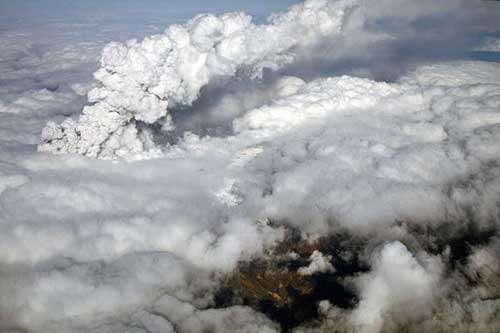August 31, 2015 report
Study ties most severe extinction to ancient volcanic activity

(Phys.org)—A pair of researchers with MIT has found a way to set a time line for volcanic activity in what is now Siberia, over 250 million years ago, and the worst mass extinction that ever occurred on our planet. In their paper published in the journal Science Advances, Seth Burgess and Samuel Bowring describe how they were able to precisely date both the volcanic activity and the mass extinction that occurred, tying the two events together.
Scientists have known for quite some time that a mass extinction occurred at the end of the Permian period, causing the extinction of approximately 90 percent of all marine species, and 75 percent of land dwellers. They also knew that some massive volcanic activity had occurred in what is now Siberia, perhaps during roughly the same time period. Because of this, there were suggestions that the eruptions had caused the extinctions, but until now, no one had been able to time either event precisely enough to show that was what really happened.
To obtain such precise measurements, the two researchers used radioactive dating techniques on hundreds of samples scattered across approximately 2.5 million square kilometers of land, noting the differences in crystals that would have come from material that was explosively ejected versus others that were likely part of voluminous magna (approximately 3 million cubic meters) that also came from the volcanoes. Ratios of uranium to lead in the crystals allowed for creating a timeline. Their analysis indicated that the period of volcanic activity began approximately 300,000 years before the start of the mass extinction and then continued on for another half million years. This suggests that the mass extinction was indeed caused by the eruptions—high levels of carbon dioxide and other gases would have been spewed into the atmosphere, causing very serious climate change, including acidification of the oceans—making life very difficult for all living things on the planet.
Still unexplained, however, is why the planet took so long to make a comeback—prior research has shown it took between five and ten million years for the Earth's climate to return to a state that was capable of hosting a more diverse ecosystem.
More information:
High-precision geochronology confirms voluminous magmatism before, during, and after Earth's most severe extinction, Science Advances 28 Aug 2015:
Vol. 1, no. 7, e1500470. DOI: 10.1126/sciadv.1500470
Abstract
The end-Permian mass extinction was the most severe in the Phanerozoic, extinguishing more than 90% of marine and 75% of terrestrial species in a maximum of 61 ± 48 ky. Because of broad temporal coincidence between the biotic crisis and one of the most voluminous continental volcanic eruptions since the origin of animals, the Siberian Traps large igneous province (LIP), a causal connection has long been suggested. Magmatism is hypothesized to have caused rapid injection of massive amounts of greenhouse gases into the atmosphere, driving climate change and subsequent destabilization of the biosphere. Establishing a causal connection between magmatism and mass extinction is critically dependent on accurately and precisely knowing the relative timing of the two events and the flux of magma. New U/Pb dates on Siberian Traps LIP lava flows, sills, and explosively erupted rocks indicate that (i) about two-thirds of the total lava/pyroclastic volume was erupted over ~300 ky, before and concurrent with the end-Permian mass extinction; (ii) eruption of the balance of lavas continued for at least 500 ky after extinction cessation; and (iii) massive emplacement of sills into the shallow crust began concomitant with the mass extinction and continued for at least 500 ky into the early Triassic. This age model is consistent with Siberian Traps LIP magmatism as a trigger for the end-Permian mass extinction and suggests a role for magmatism in suppression of post-extinction biotic recovery.
Journal information: Science Advances
© 2015 Phys.org



















